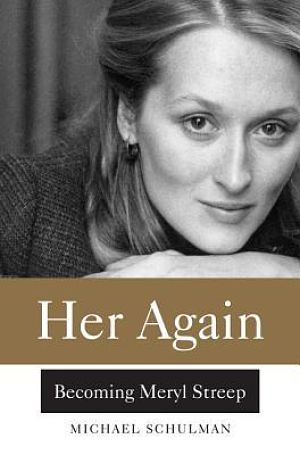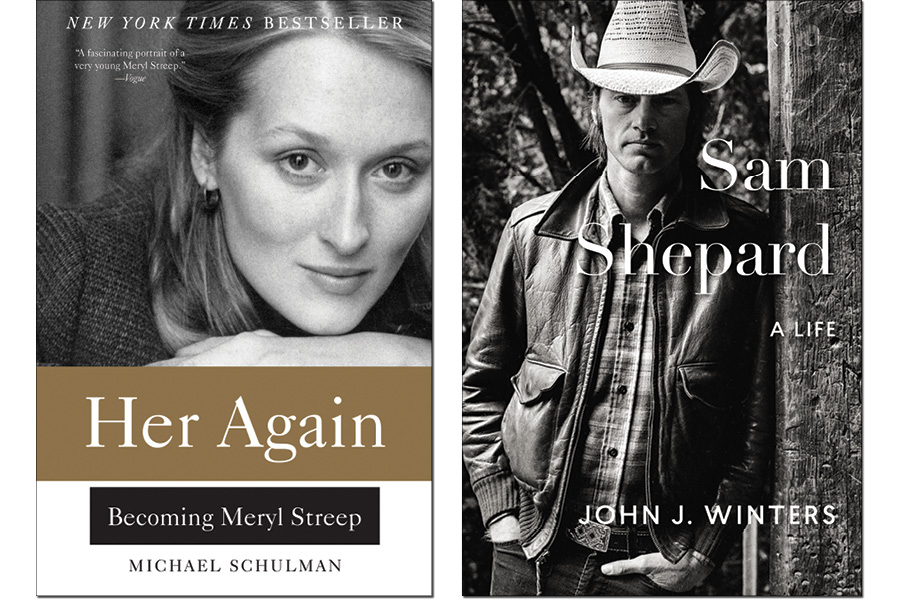Though Steve Rogers and Meryl Streep appeared on the New York theatre scene just over a decade apart, their launches into stardom could not have been more dissimilar.
After a stint at a community college, Rogers got off a bus from Duarte, Calif., and sold a pint of blood to buy a cheeseburger at the Times Square White Castle. With just a single acquaintance in New York City, Rogers supported himself by waiting tables at the Village Gate in 1964, soon gave up the acting dream, and took to writing one-act plays under the name Sam Shepard.
As a girl in middle-class Bernardsville, N.J., young Streep feasted on Broadway musicals, shared a singing teacher with Beverly Sills, and won a spot on the cheerleading squad (as well as the heart of the high school football captain). In 1975, after pocketing a degree from Vassar College and surviving four years as the star of her graduate acting class at Yale, she immediately snagged a lead on Broadway. Less than a year later her mentor would be Joseph Papp.
Despite their differences, Shepard and Streep both grew up as straight arrows, only to discover, as artists will, that the roles they accepted early in life were a far cry from their authentic selves.
Shepard, raised by an abusive and alcoholic father, wrote both covertly and openly about being raised on a steady diet of fear and guilt. But in the comprehensive and zealously researched Sam Shepard: A Life, biographer John J. Winters contradicts the troubled-youth portrait promoted by Shepard himself. Employing such evidence as interviews with classmates (who claim drugs and booze were scarce) and a remarkable photograph of Steve Rogers, dressed in plaid pants and a letter sweater, performing as a yell leader, Winters argues that Rogers was unlikely to have run with the wrong crowd.
In Her Again: Becoming Meryl Streep, Michael Schulman unearths a similar contradiction in accounts of Streep’s early years. Often dressed like a teacher or secretary, Streep draped herself in the role of the “pretty but not stuck-up prom queen.” College and theatre freed her to discard that shallow persona and recognize it as bad acting.

What Sam Shepard lacked in education, training, and connections, he made up for in timing, imagination, and chutzpah. New York in 1964 was the right moment to become a playwright. Real estate was relatively cheap, and a handful of small venues were blossoming into what came to be known as Off-Off-Broadway. Within a few years, Steve Rogers was transformed from teenage waiter to “generally acknowledged genius” Sam Shepard, based on a handful of outrageous and attention-getting one-acts. With scant regard for plot or three-dimensional characters, these eruptions of surrealistic language captured the fissuring of a nation on the cusp of war. They were all voice, and the voice was unique.
Chicago, one of his most successful one-acts, was dashed off in a day and produced a month later. Back then, Shepard never bothered to rewrite. He admitted decades later that his early approach was to “throw a lot of shit against the wall and hope some of it stuck”; he chalked up the originality to the confidence of ignorance. If ever there was a playwright who learned his craft in front of an audience, it was Shepard.
Edward Albee and others had already broken free from conventional realism, but Shepard found influences elsewhere. As the first Shepard biographer with access to important archives, letters, and play drafts, Winters is able to dismantle the Shepard creation myth of a genius sprung from the womb. He zeroes in on the impact of Kerouac and the “bop prosody” of the Beats on a playwright who was initially drawn to poetry. He also highlights one of the few gifts bequeathed by Shepard’s tormented father, an awareness of jazz, enhanced by hanging out at the Village Gate and crashing in Greenwich Village with a former classmate from Duarte High named Charles Mingus Jr., son of the legendary jazzman.
Winters admits there may be more trenchant analyses of the plays than those he offers, but he sets his sights on charting the pressure of Shepard’s life on his plays and the influence of colleagues, lovers, and friends. One of the playwright’s most important relationships was with Johnny Dark, his first father-in-law. Thanks to a documentary and a book of their correspondence, Dark emerges as a calming influence on the impetuous Shepard.
He also introduced the playwright to the writings of G.I. Gurdjieff, who was to be Shepard’s spiritual guiding star for much of his life. Gurdjieff preached a kind of mindfulness, an immersion in sensation as an antidote to the chatter of the outside world. Having refused to apply “all that psychological stuff” to his plays or his life, Shepard found in the master’s teachings a way of explaining his personal and artistic existence. Wherever he traveled, Shepard sought out a Gurdjieff meeting.
While in self-exile in London, Shepard connected with another Gurdjieff disciple, Peter Brook, who would also become an important influence. Brook offered Gurdjieff’s teachings as an alternative to living the frantic artist’s life in NYC, and they were also a perfect fit for the playwright’s dismissal of a fixed personality and his support for the idea of individual character as malleable and ever changing. Gurdjieff’s teachings filled a void and offered a kind of community for the shy and reclusive Shepard. They also served, in Shepard’s own words, to “change the direction” of his work.
The new emphasis would lead to the character-driven plays that continue to be revived—Buried Child, True West, and Fool for Love. Nonetheless, Shepard would maintain a link to Off-Off-Broadway, notably in his relationship with Joseph Chaikin. The two men met at a party in 1964 and walked out together. It was an odd-couple relationship but one that would endure: Over nearly four decades, they would write, perform together, and correspond frequently. The disciplined, authentic Chaikin was Shepard’s mentor and his “touchstone to the experimental.” He brought out the best in Shepard, who was at his side whenever he was ill.
Most revealing in Winters’s book is just how much Shepard’s writing came from his own experience. Chicago sprang forth when girlfriend Joyce Aaron accepted a job out of town; True West was imbued with Shepard’s extensive knowledge of the film world; Fool for Love was fueled by the emergence of his relationship with Jessica Lange, described in detail for the first time in Winters’s book. The two met during the filming of Frances, and the chemistry between them was palpable. For a year Shepard agonized over his marriage, finally deserting an angry wife (O-Lan Jones) and a 13-year-old son who idolized him.
Fool for Love opened a month before Shepard’s departure. His notebook entries reveal the agony he was in, as if they were lines from the play: “Me: I’m in the eye of my own hurricane…Something is taking me somewhere.”

Fate and destiny, the Scylla and Charybdis of most of Shepard’s writing, are the essential building blocks of The One Inside, published in February, five months before the author’s death. Unlike earlier prose collections of vignettes and short stories, his last published work is an overtly autobiographical novella and a final return to the tropes of fractured identity, the fiendish pull of family, and the temptations of lust. The word exile ambushes the reader repeatedly, as a dislocated young man struggles to find an anchor. Dreams, ghosts, and reality flow together in a reminder of Shepard’s earlier surrealistic style. Echoing Beckett—an influence Shepard eventually acknowledged—there is more than a whiff of mortality.
Although their paths never crossed, Shepard and Streep followed a common trajectory from theatre fame to cinema stardom. As a highly trained stage performer, Streep took to film acting with great ease. On the other hand, just as with playwriting, Shepard learned on the job. In his early films, directors cut as many of his lines as they could but couldn’t resist his authentic Western look and smoldering sexuality. Eventually film acting became a way for Shepard to finance farms, livestock, horses, and polo racing. But no matter how many acting gigs he took for the money, no matter how many books of prose produced, Shepard continued to return to the theatre, a lover he never forsook.

It may be hard to imagine now, but Meryl Streep was once the darling of New York theatre. After graduating Yale and performing to great acclaim at Yale Repertory Theatre, she whizzed through the city like a shooting star. Debuting in Trelawney of the Wells at Lincoln Center in the winter of 1975 when Papp was its producer, she went on to rack up rave reviews for a stunning range of roles. A character actress in a leading-lady mold, she proceeded to perform on Broadway and at the Delacorte Theater multiple times, and receive a Tony nomination one year out of graduate school. She also secured an all-important Upper East Side sublet.
Within the space of four years, another Meryl Streep—or so it seems—landed the notoriously powerful agent Sam Cohn and built an estimable film résumé with lightning speed, appearing in Julia, Manhattan, and, in a major role, The Deer Hunter. She won an Oscar for Kramer vs. Kramer (shot while she was performing The Taming of the Shrew in Central Park) and an Emmy for the miniseries “Holocaust.” She took care of a dying boyfriend (the actor John Cazale), married sculptor Don Gummer six months after Cazale’s death, and in short order gave birth to her first child and appeared on the cover of Newsweek. It was a breathless ascent that paid tribute to Streep’s talent and willpower.
In his breezily entertaining love-letter bio—the third book on Streep to be published in the past four years—Schulman focuses on the early development of this acting dynamo (his most original research may have been tracking down Streep’s high school boyfriend), a clever strategy that allows him to construct a story of a woman who modeled herself on fashion-magazine subjects, acted the part of the all-American conformist, and left behind a superficial persona to become a fearless artist and feminist.
The climax of the book is Streep’s demand for a rewrite of the final scene in Kramer vs. Kramer (she wrote the final lines for her character herself), a film Schulman pinpoints as the first to meld her talent and conviction. (Never mind that when the film was released, many found Joanna Kramer’s willingness to give up her son profoundly anti-feminist.)
Had he pushed further into her life, Schulman would certainly have found more convincing evidence of an activist/feminist perspective: a courageous statement at the National Board of Review Awards in 2013, in which she labeled Walt Disney “anti-Semitic” and a “gender bigot”; her role as spokesperson for the National Women’s History Museum (to which she has donated heavily); and her funding for the Writer’s Lab, the only initiative for female screenwriters over 40 years old.
Using the default designation of “Greatest Living Actress” (Isabelle Huppert fans might demur) and the short time frame allows Schulman to avoid weighing in on most of Streep’s movies, few of which are in fact lasting works of cinema. The book’s title attests to her multiple Oscars and to what Schulman regards as an excellence “so self-evident that it’s become a running joke.” Not all critics concur—the Los Angeles Times’s Charles McNulty, for one, has observed that many Streep roles have fallen into two varieties: “artful drag burlesques (the Anna Wintour-ish tyrant Miranda Priestly in The Devil Wears Prada, the cluck-clucking Julia Child in Julie & Julia, and the holy-terror nun in Doubt) and relaxed diva charm-fests (aging hippie Donna of Mamma Mia! and the spurned Santa Barbara divorcée rediscovering romance in It’s Complicated).” As amusing as these outsize portrayals were, the irony is that they were also acts of “elaborate imposture,” perhaps better suited to the stage than the screen.
And there’s a crucial question that Schulman’s account never raises: How is it that one of our most gifted stage actors could spend four years tearing up New York theatre and then, with the exception of two productions at the Delacorte, leave it behind entirely? This is no doubt an impolitic query in the age of market supremacy. But Schulman presents theatre as the place nearest and dearest to Streep’s heart, the church at which she worshipped. The Streep he describes hardly seems like a person easily seduced by the glamour of Hollywood. Perhaps when a Streep biographer has more than a limited number of third-party interviews to work with—Winters’s broader canvas in Shepard could serve as a model—an answer will emerge.
When Joe Papp was dying of cancer in 1991, the grapevine buzzed with talk of candidates who would succeed him at the Public Theater. In a move that startled most observers and Streep herself, he named her his successor. She declined immediately, touched by his loyalty but “stupefied that he could misconceive me so thoroughly.”
Some would remark that Papp chose Streep because he wanted a celebrity but not another impresario. That may be true, but perhaps there was another reason: Reaching out to Streep may have been a final attempt to return to the stage one of its most gifted performers.
Writer and director Michael Bloom is the author of Thinking Like a Director.


